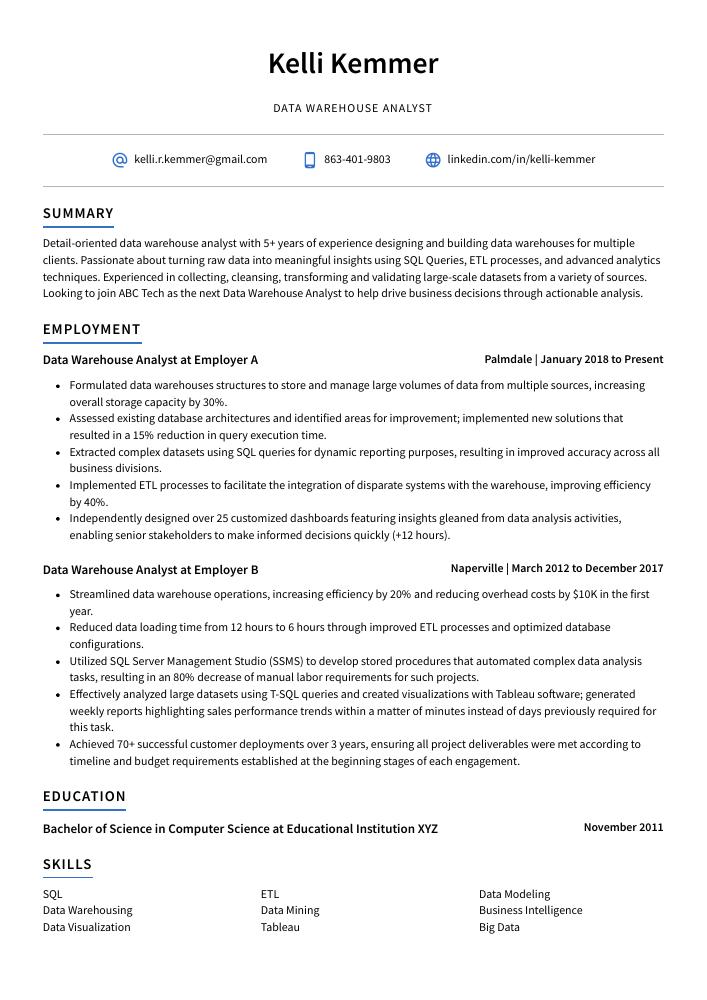Data Warehouse Analyst Resume Guide
Data Warehouse Analysts are responsible for designing, developing and maintaining an organization’s data warehouse. They use data mining techniques to extract meaningful information from large datasets, analyze the results of their queries, develop reports and visualizations based on their findings, and provide insights that can help improve business processes.
You have a knack for analyzing data and discovering insights; it’s almost like magic. However, employers don’t know of your expertise yet. To make them aware of your abilities, you need to create an eye-catching resume that captures their attention.
This guide will walk you through the entire process of creating a top-notch resume. We first show you a complete example and then break down what each resume section should look like.
Table of Contents
The guide is divided into sections for your convenience. You can read it from beginning to end or use the table of contents below to jump to a specific part.
Data Warehouse Analyst Resume Sample
Kelli Kemmer
Data Warehouse Analyst
kelli.r.kemmer@gmail.com
863-401-9803
linkedin.com/in/kelli-kemmer
Summary
Detail-oriented data warehouse analyst with 5+ years of experience designing and building data warehouses for multiple clients. Passionate about turning raw data into meaningful insights using SQL Queries, ETL processes, and advanced analytics techniques. Experienced in collecting, cleansing, transforming and validating large-scale datasets from a variety of sources. Looking to join ABC Tech as the next Data Warehouse Analyst to help drive business decisions through actionable analysis.
Experience
Data Warehouse Analyst, Employer A
Palmdale, Jan 2018 – Present
- Formulated data warehouses structures to store and manage large volumes of data from multiple sources, increasing overall storage capacity by 30%.
- Assessed existing database architectures and identified areas for improvement; implemented new solutions that resulted in a 15% reduction in query execution time.
- Extracted complex datasets using SQL queries for dynamic reporting purposes, resulting in improved accuracy across all business divisions.
- Implemented ETL processes to facilitate the integration of disparate systems with the warehouse, improving efficiency by 40%.
- Independently designed over 25 customized dashboards featuring insights gleaned from data analysis activities, enabling senior stakeholders to make informed decisions quickly (+12 hours).
Data Warehouse Analyst, Employer B
Naperville, Mar 2012 – Dec 2017
- Streamlined data warehouse operations, increasing efficiency by 20% and reducing overhead costs by $10K in the first year.
- Reduced data loading time from 12 hours to 6 hours through improved ETL processes and optimized database configurations.
- Utilized SQL Server Management Studio (SSMS) to develop stored procedures that automated complex data analysis tasks, resulting in an 80% decrease of manual labor requirements for such projects.
- Effectively analyzed large datasets using T-SQL queries and created visualizations with Tableau software; generated weekly reports highlighting sales performance trends within a matter of minutes instead of days previously required for this task.
- Achieved 70+ successful customer deployments over 3 years, ensuring all project deliverables were met according to timeline and budget requirements established at the beginning stages of each engagement.
Skills
- SQL
- ETL
- Data Modeling
- Data Warehousing
- Data Mining
- Business Intelligence
- Data Visualization
- Tableau
- Big Data
Education
Bachelor of Science in Computer Science
Educational Institution XYZ
Nov 2011
Certifications
Certified Data Warehouse Analyst
Data Warehouse Institute
May 2017
1. Summary / Objective
A resume summary/objective is the first thing a hiring manager will see when they look at your data warehouse analyst resume, so it’s important to make sure you get it right. In this section, you should highlight your experience in designing and developing databases for large organizations as well as any certifications or awards that demonstrate your expertise. You can also mention how you have successfully implemented ETL processes and optimized query performance on multiple occasions.
Below are some resume summary examples:
Reliable data warehouse analyst with 5+ years of experience in data analysis and database design. Highly skilled in designing, developing, and maintaining complex databases for multiple clients. Proven success in building ETL processes to move data from source systems into the warehouses as well as creating reports that meet both business requirements and customer needs. Excellent communication skills which enable successful collaboration among teams, stakeholders, partners, etc.
Accomplished data warehouse analyst with 8+ years of experience in data engineering and analytics. Skilled at collecting, cleansing, transforming, and loading large datasets for use in business intelligence applications. Proven track record of analyzing complex data sets to identify trends and develop actionable insights that improve decision-making accuracy by 30%. Seeking a role at ABC Company where my expertise can drive intelligent digital transformation initiatives.
Talented data warehouse analyst with 4+ years of experience developing and deploying data models to support business objectives. Expert in SQL, ETL processes, and reporting platforms such as Power BI and Tableau. At XYZ company improved the accuracy of monthly financial reports by 50% through effective data management strategies. Seeking to join ABC team as a Data Warehouse Analyst where I can utilize my skills to create actionable insights for stakeholders.
Determined data warehouse analyst with 5+ years experience in developing and managing large-scale data warehouses. Proven track record of designing, building, and maintaining ETL processes to ensure accuracy of data sources for analytics purposes. Skilled at troubleshooting problems related to data extraction, transformation and loading (ETL). Experienced in utilizing Tableau Desktop for creating visualizations that are insightful yet easy to understand.
Amicable and highly analytical data warehouse analyst with 5+ years of experience in designing and developing ETL processes, creating database tables, and troubleshooting data issues. Achieved 92% on-time project completion rate at Company X. Seeking to join ABC Tech as a Data Warehouse Analyst – leveraging expertise in SQL queries, SSIS & SSRS development, BI tools integration and analytics – to develop innovative solutions for clients across the globe.
Proficient data warehouse analyst with 5+ years of experience optimizing and maintaining data models for large-scale organizations. Skilled at building complex ETL processes to ensure accuracy, integrity, and security of information systems. Seeking a position at ABC Corporation where I can utilize my expertise in database administration and integration to deliver business insights through efficient data analysis solutions.
Dependable data warehouse analyst with 3+ years of experience in designing and managing data warehouses. Proven track record of developing efficient ETL processes to extract, transform, and load large amounts of data from multiple sources into the warehouse for reporting purposes. Experienced in working with business stakeholders to define requirements for new projects as well as maintaining existing systems.
Professional data warehouse analyst with 8+ years of experience in data analysis, ETL processes and systems design. Proficient in SQL, PL/SQL and Oracle databases. Experienced at creating comprehensive reports for stakeholders to make sound business decisions. At XYZ Company, successfully designed a complex data model to increase accuracy of reporting by 20%.
2. Experience / Employment
The work history/experience section is where you talk about your employment history. It should be written in reverse chronological order, which means that the most recent job is listed first.
Stick to bullet points when writing this section; doing so makes it easier for the reader to take in the information quickly and accurately. When writing each bullet point, make sure to include details of what you did and any quantifiable results achieved.
For example, instead of saying “Created data warehouse models,” you could say, “Designed a data warehouse model with an ETL process that increased query performance by 25%, resulting in faster report generation.”
To write effective bullet points, begin with a strong verb or adverb. Industry specific verbs to use are:
- Analyzed
- Modeled
- Designed
- Developed
- Implemented
- Optimized
- Monitored
- Administered
- Extracted
- Transformed
- Loaded
- Validated
- Documented
- Troubleshot
- Automated
Other general verbs you can use are:
- Achieved
- Advised
- Assessed
- Compiled
- Coordinated
- Demonstrated
- Expedited
- Facilitated
- Formulated
- Improved
- Introduced
- Mentored
- Participated
- Prepared
- Presented
- Reduced
- Reorganized
- Represented
- Revised
- Spearheaded
- Streamlined
- Structured
- Utilized
Below are some example bullet points:
- Expedited the data warehouse migration process by 40%, ensuring that all relevant systems were migrated within the given timeline.
- Monitored data quality and integrity in databases, identifying discrepancies or inconsistencies in datasets; resolved issues with minimal disruption to services.
- Thoroughly reviewed current system architecture and database structures, making modifications and amendments as needed for optimal performance of enterprise systems.
- Structured complex information into logical models and created ETL scripts using SQL & Python to facilitate efficient transfer of large volumes of data from multiple sources into target databases; improved loading speed by 65%.
- Revised security protocols in order to ensure compliance with industry standards while protecting sensitive business intelligence stored on the company’s cloud-based platform; decreased unauthorized access attempts by 56%.
- Represented the Data Warehouse team in meetings with other IT departments, ensuring that all data-related decisions were aligned with business objectives and contributing to a 15% improvement in operational efficiency.
- Documented detailed system processes and procedures for the warehouse operations, helping to improve compliance and consistency of practices across different teams.
- Accurately analyzed large quantities of data from multiple sources to identify patterns or trends; reported on key insights which led to improved strategic decision making by management.
- Administered daily maintenance activities related to ETL jobs, database backups, index rebuilds & integrity checks within the DW environment; completed tasks 10% faster than industry average while maintaining 0 errors rate throughout tenure as analyst.
- Reorganized existing databases structures using SQL scripts for optimization purposes; boosted query speed performance by 30%, significantly improving user experience when utilizing reports generated from the Data Warehouse systems.
- Prepared and tested over 300 data warehouse models using ETL tools, SQL, and other scripting languages; increased efficiency of the system by 20%.
- Analyzed business requirements to design and develop optimal database solutions for data warehousing initiatives; successfully migrated 6TB worth of legacy databases in 10 days.
- Developed dashboards with visualization tools such as Tableau & Power BI to provide stakeholders with real-time insights into operational performance metrics.
- Optimized data warehouses through indexing techniques, query optimization and automation processes; reduced average response time of queries from 8 minutes to 2 minutes on a daily basis.
- Meticulously monitored user permissions across systems while ensuring compliance with GDPR regulations; enabled safe sharing of confidential customer information at all times throughout the organization.
- Troubleshot and resolved data warehouse issues to ensure the accuracy and reliability of stored data, resulting in a 50% reduction of database downtime.
- Introduced advanced analytics techniques such as predictive modeling and forecasting to improve operational efficiency by 30%.
- Participated in designing complex ETL processes that integrated multiple sources into an enterprise-level Data Warehouse system; reduced time spent on manual entry tasks by 35 hours per week.
- Modeled over 200 tables with normalized schemas using SQL Server Management Studio (SSMS) while ensuring optimal query performance through indexing strategies; achieved 95th percentile rank for all queries executed against the data warehouse within 1 year of implementation.
- Substantially increased customer insights visibility across business departments through building real-time dashboards & reporting solutions, increasing customer retention rate by 15%.
- Facilitated the design and development of data warehouses for 5+ clients, optimizing performance using ETL/ELT processes and ensuring the accuracy of all stored information.
- Advised on best practices in designing data warehouse schemas and developing star & snowflake models to improve overall efficiency by 25%.
- Improved query response times by 85% through indexing techniques such as bitmap indexes, B-tree structures or hash algorithms; decreased total downtime associated with queries by an average of 12 hours per month.
- Competently managed various aspects related to server installation, configuration & maintenance tasks while adhering strictly to IT standards at each stage when working on projects involving complex datasets from multiple sources.
- Spearheaded numerous initiatives geared towards upgrading current databases with more efficient software applications; successfully automated 80% of manual activities within the organization’s analytics platform in record time frame (6 weeks).
- Mentored 10 new data warehouse analysts in ETL process, SQL query development and database design; reduced training time by 50%.
- Automated the loading of large datasets into a cross-functional data warehouse system, reducing manual labor hours by 30% while ensuring accuracy of the data.
- Demonstrated an ability to create effective visualizations using Tableau that enabled stakeholders to make more informed decisions faster; increased analytics efficiency by 10%.
- Loaded hundreds of millions of rows from various sources including Oracle databases, flat files and web services into staging tables for further analysis within specified deadlines; improved overall performance by 40%.
- Proficiently used T-SQL queries to build stored procedures and views which allowed users access to pertinent information quickly with minimal effort; completed requests 5x faster than prior methods employed at the company.
- Presented complex data warehouse models to senior management, offering insights that led to a 15% increase in operational efficiency.
- Designed and implemented ETL processes for multiple databases, increasing the accuracy of information stored by 30%.
- Validated data integrity and performed periodic quality checks across all systems; identified discrepancies and improved data consistency by 50%.
- Consistently monitored performance metrics such as query time, storage utilization rate & system availability; optimized workloads resulting in an average response time reduction of 40%.
- Compiled detailed reports on database security audit findings with recommendations to improve overall safety protocols; successfully closed 45+ vulnerabilities within 5 months.
3. Skills
Skill requirements will differ from employer to employer – this can easily be determined via the job advert. Organization ABC may require the candidate to be proficient in Oracle, while Organization XYZ may prefer knowledge of Microsoft SQL Server.
As such, you want to tailor your skills section on your resume for each job that you are applying for. This is important because many companies use applicant tracking systems these days which scan resumes for certain keywords before passing them on to a human.
You should also make sure that any relevant experience or qualifications related to data warehouse analysis are highlighted here as well as other sections of your resume (such as summary and work history).
Below is a list of common skills & terms:
- Big Data
- Business Intelligence
- Data Mining
- Data Modeling
- Data Visualization
- Data Warehousing
- ETL
- Hadoop
- SQL
- Tableau
4. Education
Adding an education section on your resume will depend on how far along you are in your career. If you just graduated and have no experience, mention it below your resume objective. However, if you already have a few years of work experience under your belt, the education section can be omitted or moved to the bottom of the page.
If an education section is included, try to highlight courses related to data warehousing such as database management systems, analytics tools like Tableau or PowerBI, programming languages (e.g., SQL), and other technology-related topics that may be relevant for this type of role.
Bachelor of Science in Computer Science
Educational Institution XYZ
Nov 2011
5. Certifications
Certifications demonstrate to employers that you have the necessary knowledge and skills for a certain job. Having certifications can give you an edge over other applicants, as it shows your commitment to professional development in the field.
Be sure to include any relevant certifications on your resume when applying for jobs. This will help demonstrate that you are qualified and knowledgeable about the industry or position in question.
Certified Data Warehouse Analyst
Data Warehouse Institute
May 2017
6. Contact Info
Your name should be the first thing a reader sees when viewing your resume, so ensure its positioning is prominent. Your phone number should be written in the most commonly used format in your country/city/state, and your email address should be professional.
You can also choose to include a link to your LinkedIn profile, personal website, or other online platforms relevant to your industry.
Finally, name your resume file appropriately to help hiring managers; for Kelli Kemmer, this would be Kelli-Kemmer-resume.pdf or Kelli-Kemmer-resume.docx.
7. Cover Letter
Attaching a cover letter to your job application is a great way to show employers why you are the perfect fit for their role. It’s made up of 2 to 4 paragraphs and serves as an introduction, allowing you more space and flexibility than what your resume alone can offer.
Cover letters provide recruiters with additional information about who you are as a professional, such as career goals or skills that weren’t included in your resume. Even if it isn’t required by the employer, writing one could be just what sets you apart from other applicants!
Below is an example cover letter:
Dear Sage,
I am writing in response to your job posting for a Data Warehouse Analyst on the [company website]. With extensive experience designing and implementing data warehouses, as well as developing ETL processes, I am confident I can make a significant contribution to your organization.
In my current role at [company name], I am responsible for maintaining and improving our data warehouse. I have designed and implemented multiple enhancements that have increased performance and efficiency. For example, I created a process that automates the loading of data from our ERP system into the data warehouse, which has saved countless hours of manual work. In addition, I developed a set of custom reports that give our sales team valuable insights into customer behavior.
My technical skills include experience with SQL Server, SSIS, and Tableau. In addition, I have strong analytical and problem-solving abilities. My ability to take complex problems and break them down into manageable pieces is one of my greatest strengths. This skill has come in handy when working with large datasets or when dealing with difficult challenges during the development process.
I would welcome the opportunity to discuss how my skills and experience can benefit your organization further during an interview at your earliest convenience.
Sincerely,
Kelli
Data Warehouse Analyst Resume Templates
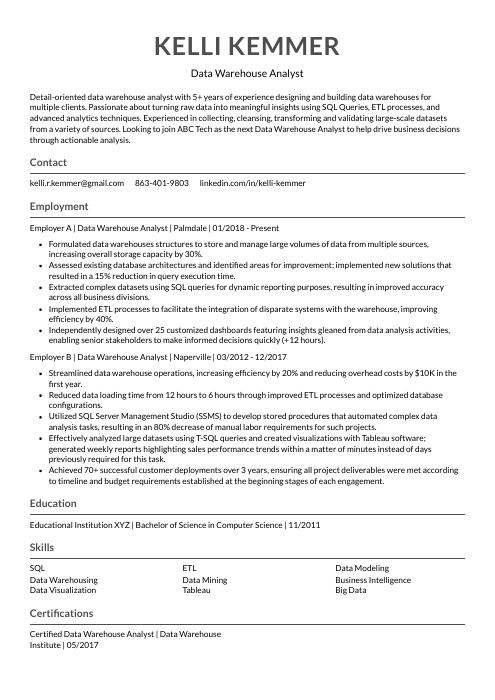 Indri
Indri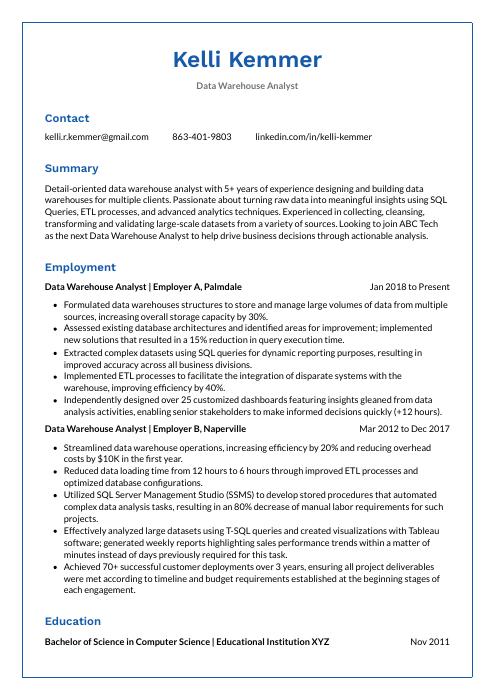 Markhor
Markhor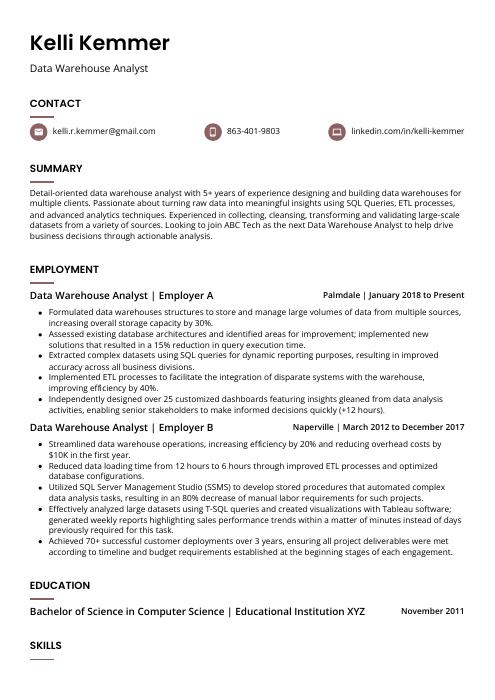 Fossa
Fossa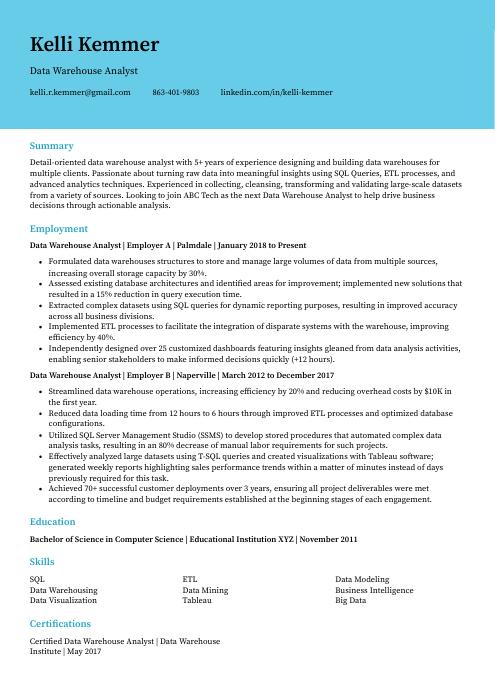 Dugong
Dugong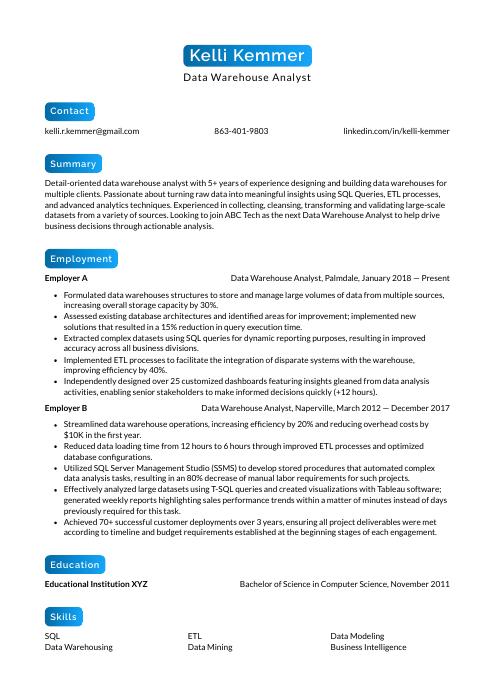 Kinkajou
Kinkajou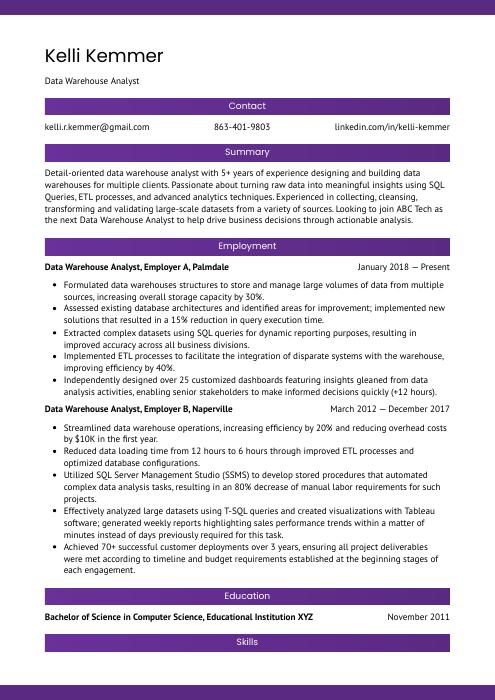 Jerboa
Jerboa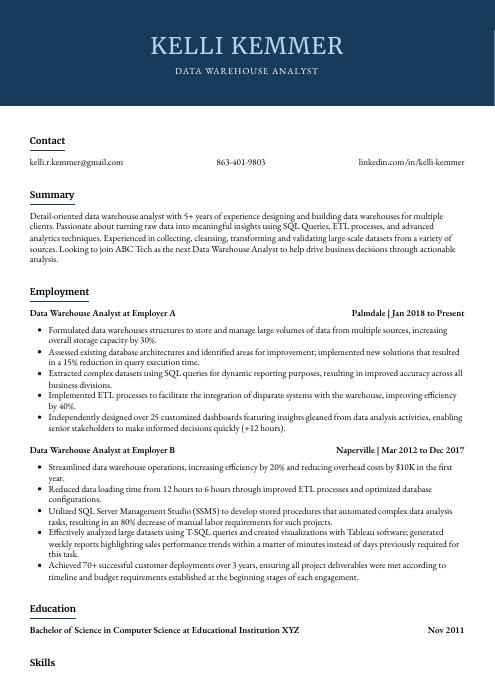 Bonobo
Bonobo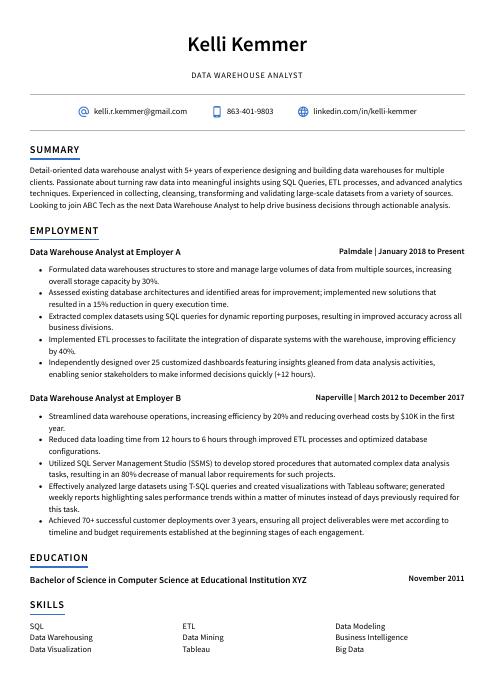 Axolotl
Axolotl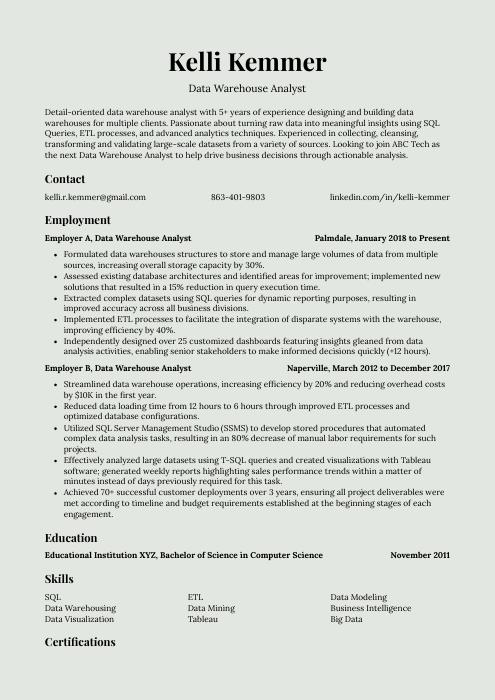 Saola
Saola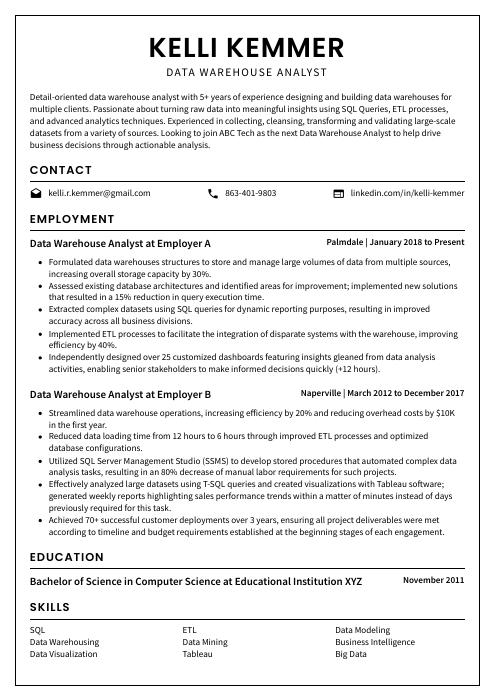 Cormorant
Cormorant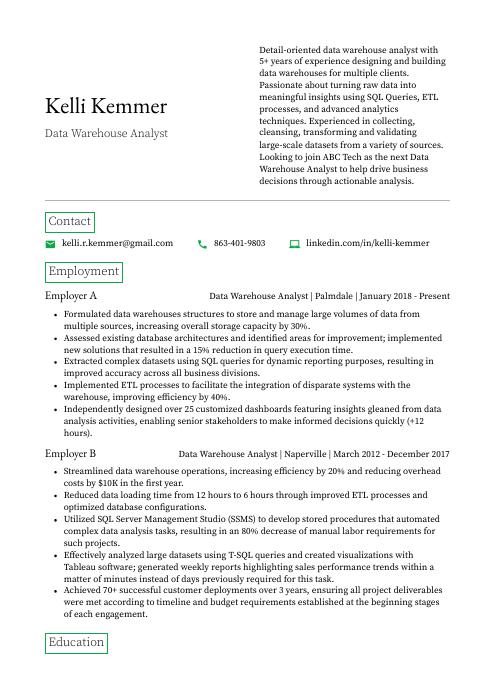 Quokka
Quokka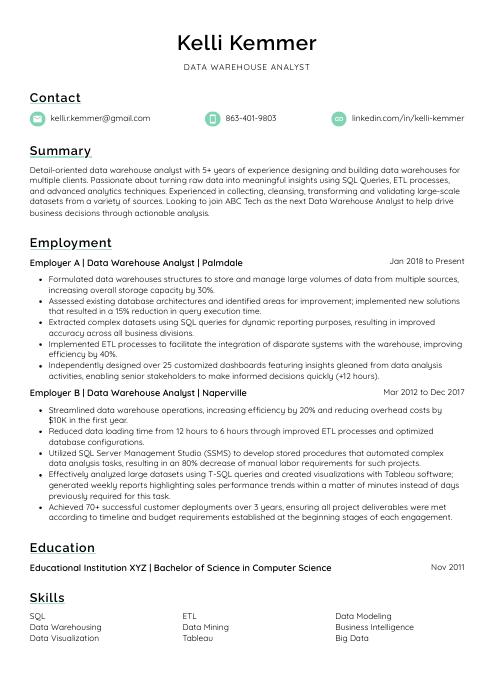 Lorikeet
Lorikeet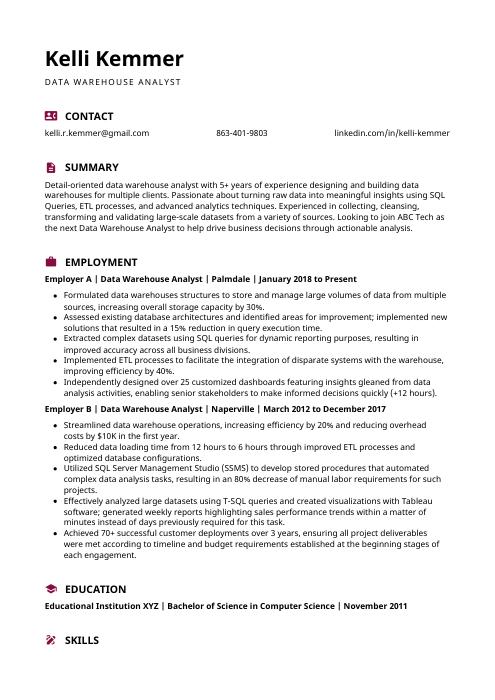 Hoopoe
Hoopoe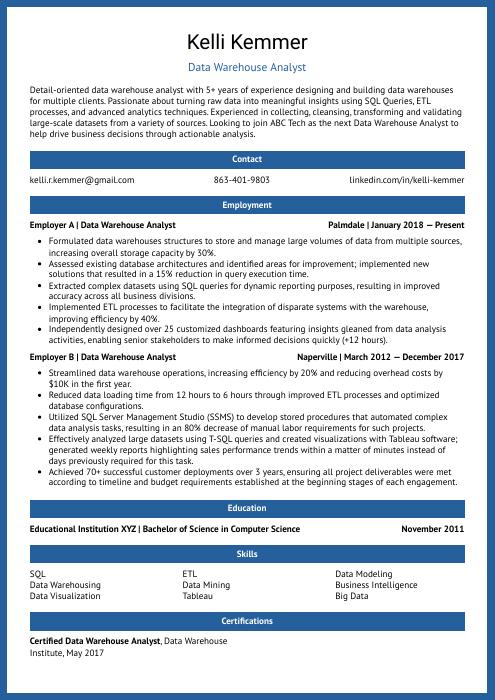 Ocelot
Ocelot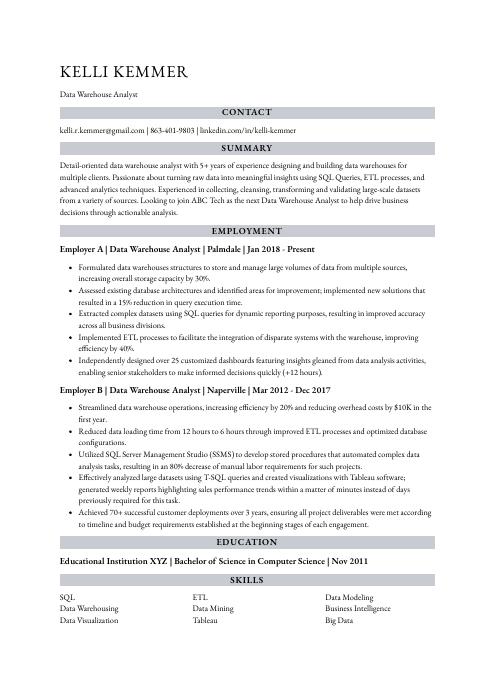 Numbat
Numbat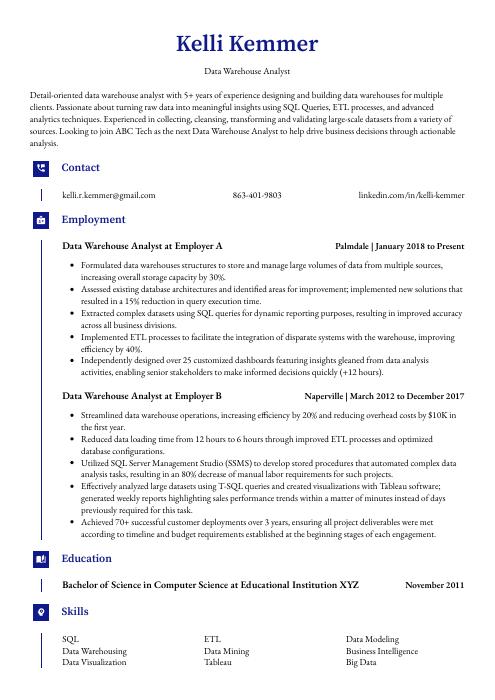 Gharial
Gharial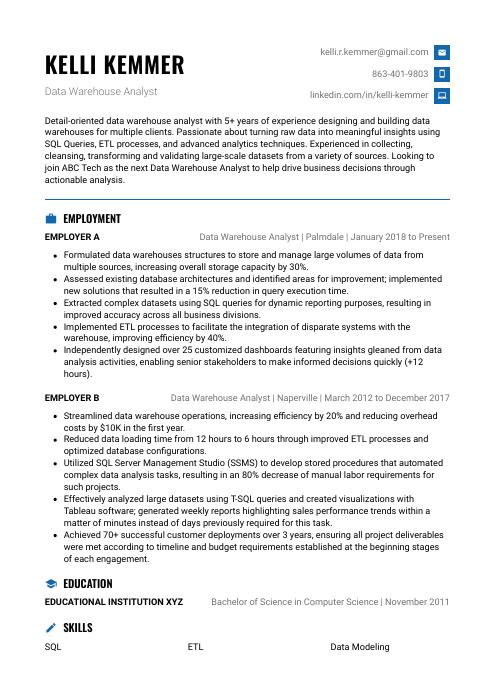 Echidna
Echidna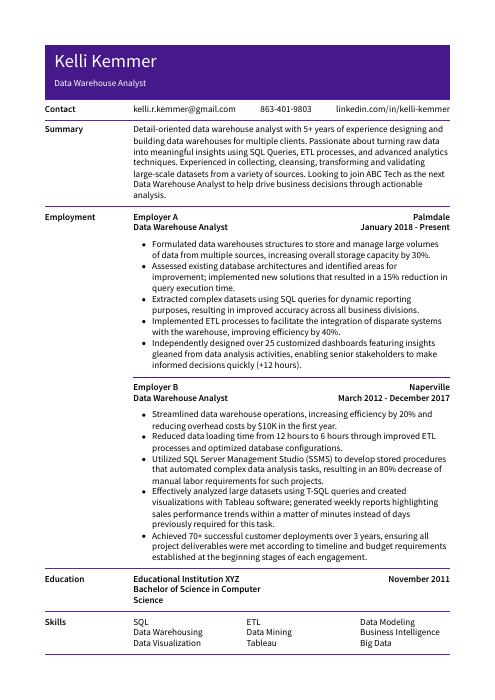 Pika
Pika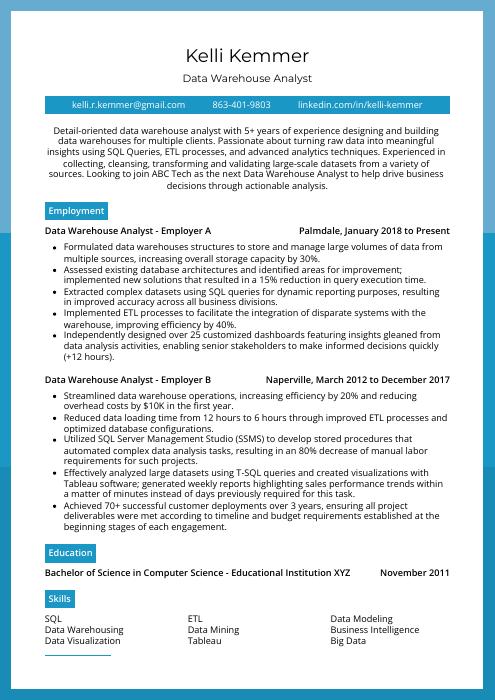 Rhea
Rhea Rezjumei
Rezjumei
